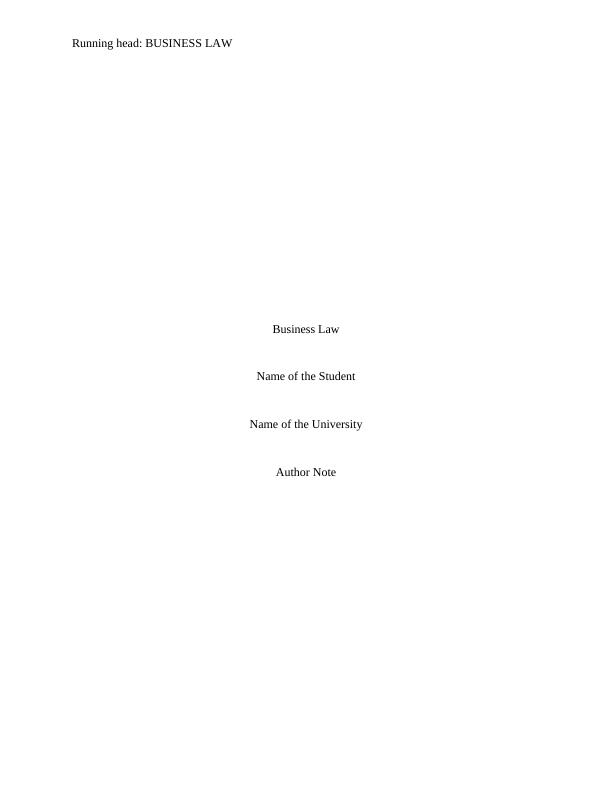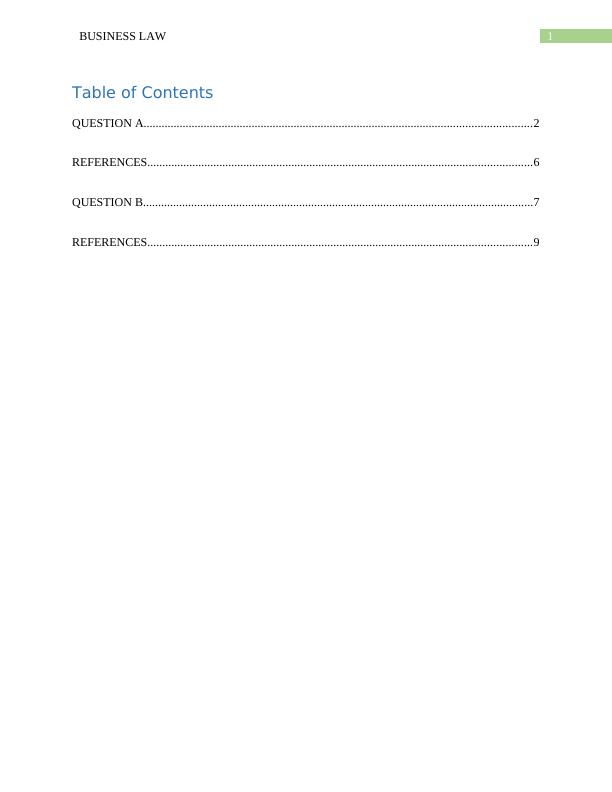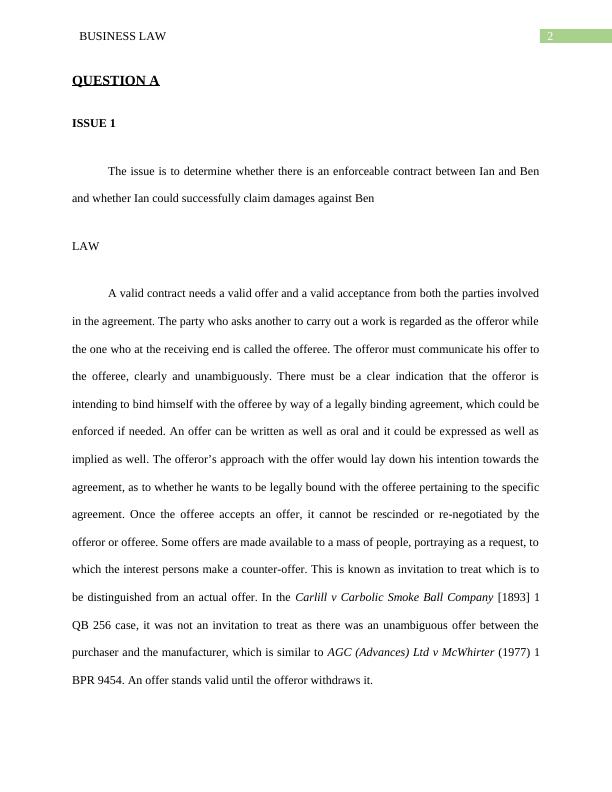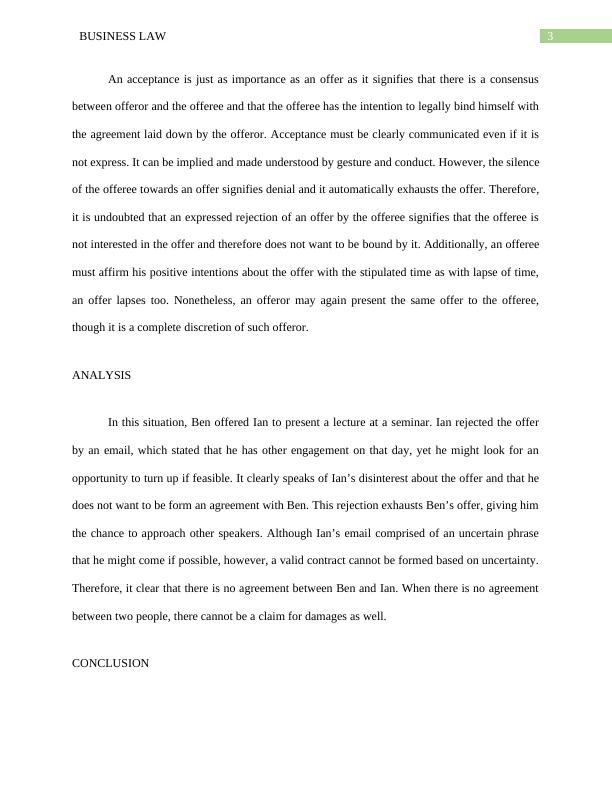Understanding Enforceable Contracts and Damages in Business Law
Added on 2023-04-23
11 Pages1856 Words417 Views
Running head: BUSINESS LAW
Business Law
Name of the Student
Name of the University
Author Note
Business Law
Name of the Student
Name of the University
Author Note

1BUSINESS LAW
Table of Contents
QUESTION A.................................................................................................................................2
REFERENCES................................................................................................................................6
QUESTION B..................................................................................................................................7
REFERENCES................................................................................................................................9
Table of Contents
QUESTION A.................................................................................................................................2
REFERENCES................................................................................................................................6
QUESTION B..................................................................................................................................7
REFERENCES................................................................................................................................9

2BUSINESS LAW
QUESTION A
ISSUE 1
The issue is to determine whether there is an enforceable contract between Ian and Ben
and whether Ian could successfully claim damages against Ben
LAW
A valid contract needs a valid offer and a valid acceptance from both the parties involved
in the agreement. The party who asks another to carry out a work is regarded as the offeror while
the one who at the receiving end is called the offeree. The offeror must communicate his offer to
the offeree, clearly and unambiguously. There must be a clear indication that the offeror is
intending to bind himself with the offeree by way of a legally binding agreement, which could be
enforced if needed. An offer can be written as well as oral and it could be expressed as well as
implied as well. The offeror’s approach with the offer would lay down his intention towards the
agreement, as to whether he wants to be legally bound with the offeree pertaining to the specific
agreement. Once the offeree accepts an offer, it cannot be rescinded or re-negotiated by the
offeror or offeree. Some offers are made available to a mass of people, portraying as a request, to
which the interest persons make a counter-offer. This is known as invitation to treat which is to
be distinguished from an actual offer. In the Carlill v Carbolic Smoke Ball Company [1893] 1
QB 256 case, it was not an invitation to treat as there was an unambiguous offer between the
purchaser and the manufacturer, which is similar to AGC (Advances) Ltd v McWhirter (1977) 1
BPR 9454. An offer stands valid until the offeror withdraws it.
QUESTION A
ISSUE 1
The issue is to determine whether there is an enforceable contract between Ian and Ben
and whether Ian could successfully claim damages against Ben
LAW
A valid contract needs a valid offer and a valid acceptance from both the parties involved
in the agreement. The party who asks another to carry out a work is regarded as the offeror while
the one who at the receiving end is called the offeree. The offeror must communicate his offer to
the offeree, clearly and unambiguously. There must be a clear indication that the offeror is
intending to bind himself with the offeree by way of a legally binding agreement, which could be
enforced if needed. An offer can be written as well as oral and it could be expressed as well as
implied as well. The offeror’s approach with the offer would lay down his intention towards the
agreement, as to whether he wants to be legally bound with the offeree pertaining to the specific
agreement. Once the offeree accepts an offer, it cannot be rescinded or re-negotiated by the
offeror or offeree. Some offers are made available to a mass of people, portraying as a request, to
which the interest persons make a counter-offer. This is known as invitation to treat which is to
be distinguished from an actual offer. In the Carlill v Carbolic Smoke Ball Company [1893] 1
QB 256 case, it was not an invitation to treat as there was an unambiguous offer between the
purchaser and the manufacturer, which is similar to AGC (Advances) Ltd v McWhirter (1977) 1
BPR 9454. An offer stands valid until the offeror withdraws it.

3BUSINESS LAW
An acceptance is just as importance as an offer as it signifies that there is a consensus
between offeror and the offeree and that the offeree has the intention to legally bind himself with
the agreement laid down by the offeror. Acceptance must be clearly communicated even if it is
not express. It can be implied and made understood by gesture and conduct. However, the silence
of the offeree towards an offer signifies denial and it automatically exhausts the offer. Therefore,
it is undoubted that an expressed rejection of an offer by the offeree signifies that the offeree is
not interested in the offer and therefore does not want to be bound by it. Additionally, an offeree
must affirm his positive intentions about the offer with the stipulated time as with lapse of time,
an offer lapses too. Nonetheless, an offeror may again present the same offer to the offeree,
though it is a complete discretion of such offeror.
ANALYSIS
In this situation, Ben offered Ian to present a lecture at a seminar. Ian rejected the offer
by an email, which stated that he has other engagement on that day, yet he might look for an
opportunity to turn up if feasible. It clearly speaks of Ian’s disinterest about the offer and that he
does not want to be form an agreement with Ben. This rejection exhausts Ben’s offer, giving him
the chance to approach other speakers. Although Ian’s email comprised of an uncertain phrase
that he might come if possible, however, a valid contract cannot be formed based on uncertainty.
Therefore, it clear that there is no agreement between Ben and Ian. When there is no agreement
between two people, there cannot be a claim for damages as well.
CONCLUSION
An acceptance is just as importance as an offer as it signifies that there is a consensus
between offeror and the offeree and that the offeree has the intention to legally bind himself with
the agreement laid down by the offeror. Acceptance must be clearly communicated even if it is
not express. It can be implied and made understood by gesture and conduct. However, the silence
of the offeree towards an offer signifies denial and it automatically exhausts the offer. Therefore,
it is undoubted that an expressed rejection of an offer by the offeree signifies that the offeree is
not interested in the offer and therefore does not want to be bound by it. Additionally, an offeree
must affirm his positive intentions about the offer with the stipulated time as with lapse of time,
an offer lapses too. Nonetheless, an offeror may again present the same offer to the offeree,
though it is a complete discretion of such offeror.
ANALYSIS
In this situation, Ben offered Ian to present a lecture at a seminar. Ian rejected the offer
by an email, which stated that he has other engagement on that day, yet he might look for an
opportunity to turn up if feasible. It clearly speaks of Ian’s disinterest about the offer and that he
does not want to be form an agreement with Ben. This rejection exhausts Ben’s offer, giving him
the chance to approach other speakers. Although Ian’s email comprised of an uncertain phrase
that he might come if possible, however, a valid contract cannot be formed based on uncertainty.
Therefore, it clear that there is no agreement between Ben and Ian. When there is no agreement
between two people, there cannot be a claim for damages as well.
CONCLUSION

End of preview
Want to access all the pages? Upload your documents or become a member.
Related Documents
Understanding Business Law: Contract Formation, Enforceability, and Legal Implicationslg...
|10
|1988
|388
Corporate /Business Law Question Answer 2022lg...
|8
|2212
|18
Contract Lawlg...
|5
|943
|435
Business Lawlg...
|10
|2331
|240
Business Law Assignment on Contract Formation and Exclusion Clauseslg...
|8
|2033
|484
(BLO1105) Business Law PDFlg...
|8
|1821
|85
